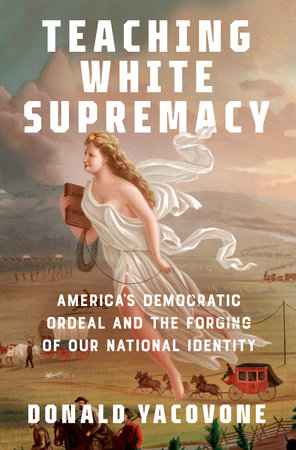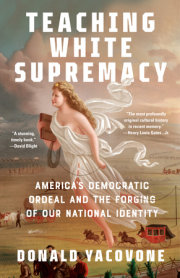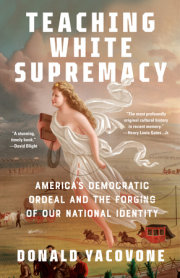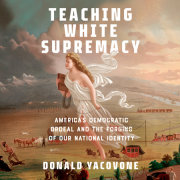1 The Contours of White Supremacy To the Caucasian race by reason of its physical and mental superiority, has been assigned the task of civilizing and enlightening the world. —Samuel Train Dutton,
The Morse Speller, 1896
Samuel Train Dutton was superintendent of schools in Brookline, Massachusetts, when he wrote the ever-popular
Morse Speller, which enjoyed its thirteenth edition in 1903. For about half a century, however, he reigned as the nation’s leading authority on school administration and public education. He also had led New Haven, Connecticut’s schools, served as superintendent of New York City’s famed Horace Mann School, and had been named professor of school administration at Columbia University. At the time of his death in 1919, he was general secretary of the League of Nations’ World’s Court League, the founder and first secretary of New York’s Peace Society, and had been a member of the International Commission on the Balkan Wars. He also helped organize colleges in Turkey and China and chaired the Armenian and Syrian relief efforts. As the country’s leading educator at the beginning of the twentieth century, he also earned worldwide renown as a diplomat and philanthropist. For all his philanthropy and insistence that American schools teach about slavery and the Civil War, Dutton also asserted that schools must explain “how the ancient Egyptians differed from the Negro, and why.” Moreover, as he advised teachers, the failures of American missionaries had proved that Native Americans and Africans were fit only for manual labor training, the kind of education appropriate for the “heathen and the savage” as well as the “vicious and defective.” The white race must take up these responsibilities as its prime mission, Dutton declared in 1896. Such Northern-born leaders who dominated American educational thinking reflected the countless ways, both subtle and blatant, that white supremacy permeated the culture.
Many historians and commentators today understandably see slavery as the nation’s “original sin.” But slavery alone cannot account for the enduring nature of prejudice against African Americans and others who lacked the “whiteness” so highly valued by educators like Dutton. Groups from Native Americans to the Irish, and some English immigrants, had endured slavery or slavery-like conditions during the era of national development. English indentured servants, especially in colonial Virginia, at times could hardly be distinguished from slaves, as their masters did everything in their power to extend their terms of service and exploit their labor. In the ancient world, people we would now recognize as “white” endured slavery, even in England. And prior to the early nineteenth century, thousands of Europeans had become slaves of North Africans. The difference in North America is the unique combination of African American slavery and the simultaneous gradual development of democratic/republican principles. Determining who should participate in this dramatic and revolutionary process, repudiating the strictly class-based organization of European society, mandated an ideology of white supremacy and acceptance of it as normal and natural. The impact of that ideology is undeniable and defining. As the popular historian and commentator Arthur M. Schlesinger, Jr., wrote over twenty years ago: “White Americans began as a people so arrogant in convictions of racial superiority that they felt licensed to kill red people, to enslave black people, and to import yellow and brown people for peon labor. We white Americans have been racist in our customs, in our conditioned reflexes, in our souls.” Borrowing from Herman Melville, Schlesinger confessed that in American history, “the world’s fairest hope” had been linked “with man’s foulest crime.”
Slavery, however, did not require racism to thrive. As a power relationship, it was an ancient institution whose benefits readily justified its means. Even John Locke, the seventeenth-century English theorist who so profoundly influenced the development of American liberty, agreed that slavery was fit punishment for captured enemies. One colonial Massachusetts judge even asserted that lawfully captured members of “Heathen Nations” could be justly enslaved. But in American colonial settlements with embryonic republican (and religious) ideas concerning rights and representation, unassailable qualifications for citizenship appeared necessary to guarantee success and justify those excluded. As Massachusetts judge John Saffin argued in 1701, God had set “different Orders and Degrees of Men in the World,” and any idea of universal equality would “invert the order that God had set.” Some were born to rule, and others were “born to be slaves, and so to remain during their lives.” Thus it proved more than an astonishing coincidence that both slavery and representative government were introduced in Virginia in the very same year. Ideas of ethnic or racial inferiority defined who could be trusted with citizenship—who would be the controlled race and who would be the controlling one, two ends of the same developing social and political contract. Each must be added to the political and social calculus to explain the unique development of American culture. But the ideology of white supremacy, not slavery, proved the more ubiquitous and more enduring institution. It became the standard by which citizenship was defined, and it determined who would prove worthy of power. White supremacy linked the Northern and Southern parts of the nation and distributed equal responsibility for slavery’s prolonged existence and the even longer life of racial repression. And it failed (temporarily) to uphold democratic society only when the nation could no longer agree on its parameters.
Rather than Southern slavery, however, it was
Northern white supremacy that proved the more enduring cultural binding force, planted along with slavery in the colonial era, intensely cultivated in the years before the Civil War, and fully blossoming after Reconstruction. Inculcated relentlessly throughout the culture and in school textbooks, it suffused Northern religion, high culture, literature, education, politics, music, law, and science. It powerfully resurfaced after the Civil War and Reconstruction to reassert control over the emancipated slaves to become the basis for national reconciliation, exploded in intensity with renewed immigration in the 1920s and ’30s, and endured with diminishing force to the present day. It succeeded as the superstructure of democratic society by allowing normal political conflict to proceed with the assurance that the assumed dangerous mudsill class (once controlled by enslavement) could pose no threat to the social order. Hence democratic equality rested on racial inequality and malleable definitions of whiteness. Moreover, it offered something more alluring than wealth, more effective than politics, and
far more appealing than education. For even the poorest of its adherents, indeed especially for them, white supremacy imparts a sense of uncontested identity and, as the American philosopher and social critic Susan Neiman wrote, an otherwise unattainable level of “dignity, simply for belonging to a higher race.” The Rev. Henry M. Field, brother of the Supreme Court justice
Stephen J. Field, who helped decide the landmark 1896
Plessy v. Ferguson case, had been born in Stockbridge, Massachusetts. The
so-called “color line,” he explained in 1890, “is not peculiar to one
section of the country; that it exists at the North as well as at the
South.” It would be a mistake, he warned, to “ascribe what we call
race-prejudice to the peculiar perversity of our Southern brethren.”
Although Reverend Field and his own children had been raised by
the former Massachusetts slave Elizabeth Freeman, also known as
Mumbet, he felt powerless to reject racism. Such sentiments, he
contended, were “a matter of instinct, which is often wiser than
reason. We cannot fight against instinct, nor legislate against it, if
we do, we shall find it stronger than our resolutions and our laws.”
North and South cherished white supremacy with equal fervor,
but how each section expressed it differed over time and place. It
had a patchwork quality, at times allowing African Americans more
freedom in some areas of the slave South than in cities or towns
of the nominally free North. Complicating the picture is the fact
that there had never been any enduring definition of a race, even
the white race. Criteria continually shifted, including and excluding
nationalities depending on conditions, levels of immigration,
and political need. Whiteness, and the idea of race, should be seen
more as a “fluid, variable, and open-ended process.” While it always
subjected people of color—and some European nationalities—to
inferior positions, the extent, intensity, and ideological motivation
or justification varied considerably over time. As described by
whites, races were defined by perceptions and appearances. Although
assumed to be biological reality, races are in fact socially constructed
categories intended to highlight the superiority and permanence
of Caucasians, even as those considered to be Caucasian changed.
Indeed, the more immigration made the North heterogenous, the
more intense became its ideas of white supremacy. Thus in the 1850s
New York’s John H. Van Evrie, the father of white supremacy, might
define Jews as white, but as immigration exploded in the 1890s,
most white Americans excluded them from membership in the
Caucasian race.
African American blood, Howard University professor Kelly Miller wrote in 1918, “flows like a stream through our national history.” But precisely where that blood flowed preoccupied Americans from the outset of their history. Samuel Sewall, remembered primarily for his role in the Salem witchcraft trials, also authored the first antislavery tract in American history. His 1700
The Selling of Joseph, largely neglected during his lifetime, denounced slavery and the slave trade as barbarous and unchristian. In his day, about one-fifth of New England families owned slaves, and by 1750 the region’s slave population had reached about ten thousand, located mostly along the coast and in the region’s lush river valleys. But as Sewall discovered, his antislavery views proved immensely unpopular. Few whites, he learned, “can endure to hear of a Negro’s being made free.” Moreover, Sewall and his fellow white settlers believed that even if freed, they “seldom use their freedom well.” He believed that such a profound difference existed between Europeans and people of African descent, “in their conditions, colour & hair,” that “they can never embody with us, and grow up into orderly Families.” They would always, Sewall concluded, “remain in our Body Politick as a kind of extravasate Blood.” Their blood might flow throughout American history, as Kelly Miller wrote, but whites would always see that blood as flowing outside the regular veins and capillaries of the nation’s body politic. They would always be alien, threatening, disdained. No matter how Blacks might use their freedom, the African presence raised such fearsome concerns for Sewall that it made him wonder if he would retain his cherished whiteness “after the Resurrection.”
Prior to North American colonization, Europeans had no settled opinion on the nature of African peoples. Many lived freely in England and across Europe. Even in slave-trading Spain, the Black explorer Juan Garrido and the Black poet and university professor Juan Latino lived there or in the country’s colonies in full freedom. Moreover, the European Catholic Church’s commissioning of appealing depictions of the African saint Maurice and his martyrdom amounted to a near obsession. Even the 1600 English translation of Leo Africanus’s
Geographical History described the African Kingdom of Timbuktu as a “well-ordered, prosperous, civilized society in which learning flourished as well as trade.”
But the hundred years of the African slave trade prior to English colonization created, in the minds of the white settlers, an association of Africans with slavery. Englishmen, whether peripatetic Capt. John Smith or Massachusetts Bay’s John Winthrop, were familiar with African slavery in the Caribbean and accepted it as a necessary and proper legal institution. Indeed, the slave trade from Africa and the Cape Verde Islands proved so profitable for New Englanders that it moved Winthrop to thank “the Lord to open to us a trade with Barbados and other Islands in the West Indies.” Even before the first African slaves appeared in Massachusetts Bay, the Puritan settlers had enslaved their Native American enemies, and many contended that the Bible’s “curse of Ham” explained the African’s signifying black skin. Smith thought Africans especially appropriate for enslavement as they originated in the “fryed Regions of blacke brutish Negers.” He also set the pattern that would ripple down throughout American history by warning that Africans were “as idle and as devilish as any in the world.” They might be natural slaves, he thought, but they represented a dangerous element to insert in the new English settlements. Despite Smith’s reservations, white settlers displayed no moral qualms about owning slaves, only about their availability and affordability.
When we hear the phrase “Jim Crow society,” we think of the South’s infamous culture of segregation and compulsory inferiority of African Americans. But Jim Crow was a Northern creation as much as a Southern one, and it long outlived the institution of slavery. Massachusetts Bay was the first colony to formally legalize slavery in 1641; in 1656 it barred African Americans from serving in the militia; and in 1705 it outlawed interracial marriage, just as the Southern colonies had done in the 1660s. Northern colonists carefully crafted laws to eliminate the possibility of social equality between whites, Native Americans, and people of African descent. Repudiating intermarriage carried powerful legal and symbolic weight, relegating African Americans to the status of “otherness” and alienation, helping to guarantee that Black blood would not flow in white veins. Any Black convicted of raping a white woman would at the very least suffer castration, but a white who raped a Black woman would suffer no penalties whatsoever. Rhode Island even outlawed the right of a Black woman, regardless of legal status, to sue a white man for paternity.
As would become a mainstay of history textbooks, Americans commonly understood that Northern slavery developed only as a mild “domestic” version of what took place in the South. Such was not the case, however, and while it was never as extensive as Southern slavery, it could be every bit as cruel. Northern owners, in what may seem counterintuitive, did not value slave children, as they brought additional costs, remained unproductive for many years, and became an unwanted distraction in the masters’ homes. When enslaved women gave birth, owners often considered the newborns to be burdens and gave them away “as soon as possible . . . like puppies.” The practice was so common and devastating to Black families that as late as 1774, Black Bostonians petitioned the colonial legislature to defend their marriages and families. “Our children are also taken from us by force,” and some were sold soon after birth. “Thus,” they decried, “our lives are imbittered to us.” But such justified protests and assertions of rights only increased the intensity of white supremacy. The more people of color accepted white practices, methods, and opinions, the more they adopted white institutions such as Christianity, and the more they lived like those about them, as the University of North Carolina history professor John Wood Sweet wrote, “the more adamant [white] settlers grew about drawing new lines of exclusion.”
Copyright © 2022 by Donald Yacovone. All rights reserved. No part of this excerpt may be reproduced or reprinted without permission in writing from the publisher.









